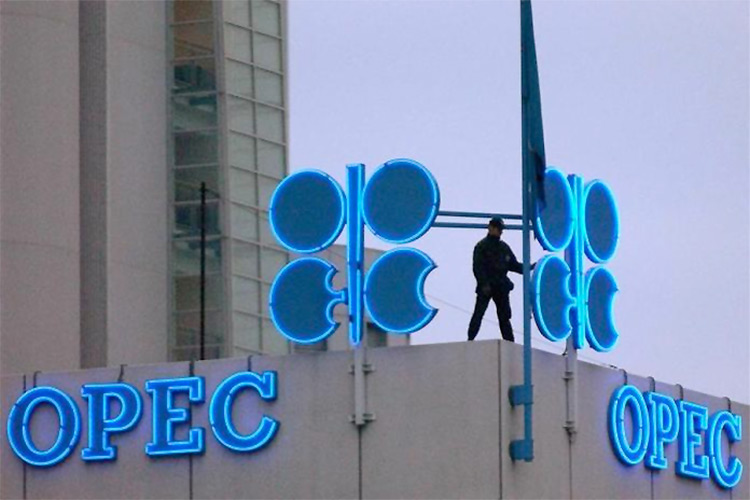Opec stresses need for 2019 oil supply cuts

Opec on Thursday cut the forecast of global demand for its oil this year as rivals boost production. Reuters
Continued supply reductions would further support oil prices, which are up about 25 per cent this year at $68 a barrel.
In a monthly report, the Organization of the Petroleum Exporting Countries said 2019 demand for its crude would average 30.46 million barrels per day, 130,000 bpd less than forecast last month and below what it is currently producing.
OPEC, Russia and other non-member producers, an alliance known as Opec+, are reducing output by 1.2 million bpd from Jan. 1 for six months. The report said rising production outside the group pressed the need for continued restraint by Opec+.
“While oil demand is expected to grow at a moderate pace in 2019, it is still well below the strong growth expected in the non-OPEC supply forecast for this year,” OPEC said in the report.
“This highlights the continued shared responsibility of all participating producing countries to avoid a relapse of the imbalance and continue to support oil market stability in 2019.” Opec sources have said an extension of the pact is the likely scenario. The group will discuss this at a meeting in April, although top exporter Saudi Arabia has said a decision may not be made until another gathering in June.
The 2019 pact was a U-turn after the producers had agreed to boost supplies in mid-2018. Opec+ changed course after prices slid from $86 in October, making them wary of a new glut.
Despite the new curbs, market indicators followed by Opec will prolong concerns about excess supply. Opec›s report said oil inventories in developed economies were above the five-year average in January.
Opec›s share of the cut is 800,000 bpd, and the report showed producers were over-delivering.
Overall Opec output fell by 221,000 bpd month-on-month to 30.55 million bpd. This was led by a drop in supply from Venezuela — exempt from the Opec cut but under US sanctions — and a further voluntary reduction by Saudi Arabia.
The 11 Opec members required to cut output achieved 105 per cent compliance in February with pledged curbs, according to a Reuters calculation, up from January. Production in Iran and Libya, also exempt, was little changed.
Even so, with the demand for Opec crude forecast at 30.46 million bpd, the report indicates that the market would still face a small 2019 surplus if OPEC kept pumping at February›s rate, as rivals such as the United States boost output.
Opec forecasts non-member producers to boost output in 2019 by 2.24 million bpd, 60,000 bpd more than expected previously. It kept its forecast for growth in global oil demand this year unchanged at 1.24 million bpd.
Russian Energy Minister Alexander Novak will not attend a monitoring panel of Opec and non-Opec oil-producing countries scheduled for Monday in Baku, two sources familiar with his plans told Reuters.
They said his deputy, Pavel Sorokin, would represent Russia at the Joint Ministerial Monitoring Committee in the Azeri capital.
Sources said Novak would be there on Sunday, along with Saudi Energy Minister Khalid Al Falih.
Meanwhile, Iraq has cut its oil exports average to 3.5 million barrels per day (bpd) in compliance with an ongoing production curb agreement, its oil minister said on Thursday.
Thamer Ghadhban told reporters that an Opec meeting in Vienna in April would assess member states› compliance with agreed production cuts and whether to extend the curbs until the end of the year.
Iraq exported on average around 3.6 million bpd in January-February, and 3.7 million in December.
Iraq is committed to the deal and working to stabilise markets, and is producing slightly more than 4.5 million bpd, below its full capacity of nearly 5 million, Ghadhban said. «We do not want severe volatility in prices because this affects producers and consumers,» he added.
Seperately, oil prices nudged higher on Thursday to sit just off a four-month high reached in the previous session as investors focused on global production cuts and supply disruptions in Venezuela.
International Brent crude oil futures were at $67.61 a barrel at 0054 GMT, up 6 cents, or 0.1 percent, from their last close. Brent touched $67.76 a barrel on Wednesday, its highest since Nov. 16.
US West Texas Intermediate (WTI) crude futures were at $58.29 per barrel, up 3 cents, or 0.1 percent, from their last settlement. WTI hit a high of $58.48 a barrel on Wednesday, the highest since Nov. 13.
«Opec continues to cut output amid ongoing supply issues, while the situation in Venezuela remains bleak,» ANZ Bank said in a research note.
Reuters



